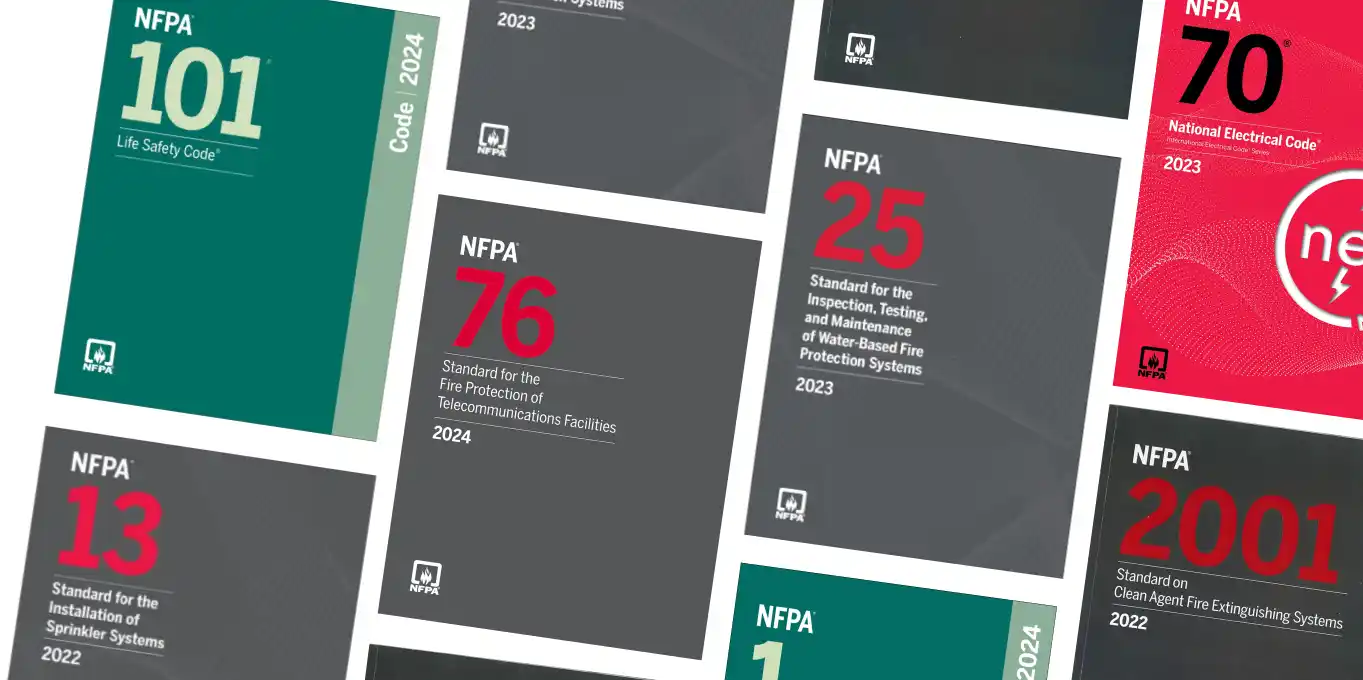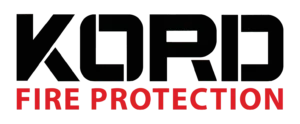

NFPA Codes and Guidelines: Solutions for Fire Protection and Life Safety
Welcome to Our NFPA Codes Resource Center
The National Fire Protection Association (NFPA) provides a comprehensive set of codes and standards designed to ensure effective fire protection and life safety. Us here at Kord Fire Protection adhere to these standards in order to maintain quality and effective functionality. Our resource center offers detailed insights into over 300 NFPA Codes and Guidelines, helping you stay informed and compliant. Explore the sections below to find in-depth articles, updates, and practical guides on each NFPA code.
1. Fire Prevention Codes:
NFPA 1: Fire Code
The Role of NFPA 1 in Modern Fire Safety: What Building Owners Should Know
This code provides comprehensive guidelines for fire prevention and protection in buildings, including design and construction requirements to mitigate fire hazards.
NFPA 3: Fire Protection And Life Safety Systems
NFPA 3 Overview: Essential Standards for Commissioning and Maintenance of Fire Protection Systems
Provides guidelines for commissioning fire protection and life safety systems to ensure proper operation and compliance.
NFPA 4: Integrated Fire Protection And Life Safety System Testing
Integrated Fire Protection Systems: Implementing NFPA 4 for Optimal Testing and Maintenance
NFPA 4 establishes standards for integrated testing of fire protection and life safety systems to ensure reliable performance and safety.
NFPA 10: Portable Fire Extinguisher Standards
How NFPA 10 Regulates Portable Fire Extinguishers: A Complete Overview
Specifies the requirements for portable fire extinguishers, including their placement and maintenance within buildings.
NFPA 11: Low-, Medium-, and High-Expansion Foam
Foam Fire Extinguishing Systems: An Overview of NFPA 11 Standards
NFPA 11 sets the standards for foam fire protection systems to enhance safety and effectiveness in combating flammable liquid fires.
NFPA 11A: Medium- and High-Expansion Foam Systems
NFPA 11A: Essential Guidelines for Medium- and High-Expansion Foam Fire Suppression Systems
Provides guidelines for the use of low-expansion foam systems to ensure effective fire protection in critical applications.
NFPA 11C: Standard for Mobile Foam Apparatus
Understanding NFPA 11C: Comprehensive Guide to Testing Foam Fire Protection Systems
NFPA 11C outlines standards for the use of high-expansion foam systems to enhance fire protection in large areas and confined spaces.
NFPA 13: Standards For Sprinkler System Installations
NFPA 13 Overview: Automatic Fire Sprinkler System Installation
Covers the design and installation of fire sprinkler systems, including requirements for sprinkler system layout, installation, and maintenance.
NFPA 14: Standards For Standpipe And Hose Systems
NFPA 14: Safeguarding Against Fire Hazards with Standpipe and Hose Systems
We go into the needed requirements for standpipe and hose systems, which are essential for fire protection within buildings.
NFPA 15: Water Spray Fixed Systems In Fire Protection
NFPA 15: Enhancing Fire Safety with Water Spray Fixed Systems
How NFPA 15 provides guidelines for water spray systems designed to protect against fire hazards in various types of buildings.
NFPA 16: Installation Of Foam Water Sprinkler and Foam Water Spray System
Understanding NFPA 16 Standard for Foam-Water Sprinkler and Spray Systems
Addresses the installation and maintenance of foam-water sprinkler and spray systems for fire protection.
NFPA 22: Fire Protection Water Storage
How NFPA 22 Regulates Fire Protection Water Tanks: What You Need to Know
We go into this specific standard for the design, construction, and maintenance of water tanks used for fire protection.
NFPA 25: Inspecting, Testing, and Maintaining Water-Based Fire Suppression Systems
Is NFPA 25 Mandatory?
Details procedures for inspecting, testing, and maintaining water-based fire protection systems.
NFPA 101: The Life Safety Code
NFPA 101 Overview: Life Safety Code For 2025
Establishes standards for building design and construction to ensure safe egress and protect building occupants.
2. Electrical Safety Codes:
NFPA 70: All About The National Electrical Code (NEC)
NFPA 70: How to Achieve and Maintain Adherence to the NEC
The NEC is a widely adopted standard for the safe installation of electrical wiring and equipment in the United States. It covers electrical systems design, installation, and inspection to ensure safety from electrical hazards.
NFPA 70B: Electrical System Maintenance
NFPA 70B: Electrical Equipment Maintenance
NFPA 70B offers guidelines for the maintenance of electrical systems to enhance safety and minimize the risk of electrical failures
NFPA 70E: Standard for Electrical Safety in the Workplace
NFPA 70E Safety Protocols: How to Protect Workers from Electrical Hazards Effectively
Focuses on electrical safety practices in the workplace to protect workers from electrical hazards.
NFPA 73: Standard for the Installation of Electrical Systems in Residential Occupancies
How NFPA 73 Enhances Electrical Safety in Existing Buildings
We’ll go over the requirements for the installation of electrical systems in residential buildings to ensure safety and compliance with electrical standards.
NFPA 74: Installation Of Low-Voltage Electrical Systems
The Importance of NFPA 74 in Ensuring Ongoing Electrical Safety and Reliability
Addresses the installation of low-voltage electrical systems, including those used in communications, security, and automation systems.
NFPA 76: Standard for the Fire Protection of Telecommunications Facilities
The Role of NFPA 76 in Securing Telecom Infrastructure Against Fire
Provides fire protection standards specifically for telecommunications facilities, including electrical and fire safety measures.
NFPA 79: Electrical Standard for Industrial Machinery
NFPA 79 Compliance in High-Risk Industries: Best Practices for Meeting Electrical Safety Guidelines
Details electrical safety standards for industrial machinery, including requirements for wiring, grounding, and protection.
NFPA 110: Emergency and Standby Power Systems
Understanding NFPA 110: Key Standards for Emergency Power Systems and Generators
Covers requirements for emergency and standby power systems to ensure reliable operation during power outages.
NFPA 111: Stored Electrical Energy Emergency and Standby Power Systems
How NFPA 111 Enhances Reliability in Stored Electrical Energy Systems
Specifies requirements for stored electrical energy systems, such as batteries and uninterruptible power supplies (UPS), used for emergency and standby power.
NFPA 780: Installation of Lightning Protection Systems
The Role of NFPA 780 in Preventing Lightning-Related Damage and Hazards
Provides guidelines for the installation of lightning protection systems to safeguard buildings and structures from lightning strikes.
NFPA 791: Recommended Practice and Procedures for Unlabeled Electrical Equipment Evaluation
The Role of NFPA 791 in Preventing Electrical Failures and Ensuring Reliability
Offers recommendations for evaluating electrical equipment that is not labeled or listed by recognized testing laboratories.
NFPA 805: Performance-Based Standard for Fire Protection for Light Water Reactor Power Plants
The Role of NFPA 805 in Preventing Fire Hazards in Nuclear Power Plants
Applies to fire protection in nuclear power plants, including electrical systems related to plant safety.
3. Building Construction Codes:
NFPA 20: Fire Pump Installation and Maintenance Standards
How NFPA 20 Regulates Fire Pump Systems: A Comprehensive Overview
Provides requirements for the installation and maintenance of stationary fire pumps used in fire protection systems.
NFPA 24: Reliable Fire Service Mains for Safety and Compliance
Navigating NFPA 24: Standards and Guidelines for Effective Private Fire Service Mains
Covers the installation of private fire service mains, including requirements for their construction and maintenance.
NFPA 30: Flammable and Combustible Liquids Code
How NFPA 30 Regulates Flammable Liquids
Provides guidelines for the storage, handling, and use of flammable and combustible liquids in buildings.
NFPA 37: Innovative Approaches to Combustion Engine and Turbine Regulations
NFPA 37: The Blueprint for Modern Combustion Engine and Gas Turbine Safety
Addresses the safe installation and use of stationary combustion engines and gas turbines, which are often part of building infrastructure.
NFPA 45: Standard on Fire Protection for Laboratories Using Chemicals
Implementing NFPA 45 for Safer Chemical Handling in Labs
We go over the fire protection requirements for lab environments that hold chemicals, to ensure a safe, secure work space. This includes design and construction considerations.
NFPA 72: Overview Of The National Fire Alarm And Signaling Code
NFPA 72 Overview
We go deep into the requirements for fire alarm systems and signaling, including their design, installation, and maintenance.
NFPA 80: Fire Doors and Other Opening Protectives
NFPA 80 Key Guidelines for Fire Door Safety Compliance
Specifies requirements for fire doors and other fire-resistant opening protective used in buildings.
NFPA 5000: Building Construction and Safety Code
Inside NFPA 5000: How Cutting-Edge Safety Standards are Shaping the Future of Building Design
The Essential Guide to Building Construction: Safety Features and Best Practices for a Secure and Well-Built Structure
NFPA 600: Industrial Fire Brigades Standards
A Beginner’s Guide to NFPA 600 Standards and Regulations
Lets go over the standards that are for industrial fire brigades. We look over the training and equipment requirements for fire protection in industrial settings.
4. Industrial and Specialized Safety Codes:
NFPA 30: The Flammable and Combustible Liquids Code
How to Ensure Compliance with NFPA 30: A Guide for Safety Managers
Provides guidelines for the safe storage, handling, and use of flammable and combustible liquids in industrial settings.
NFPA 33: Standards For Spray Application Using Flammable or Combustible Materials
The NFPA 33 Playbook: Pro Tips for Meeting and Exceeding Spray Application Standards
Covers safety requirements for spray application processes involving flammable or combustible materials.
NFPA 34: Dipping, Coating, and Printing Processes Using Flammable or Combustible Liquids
NFPA 34 vs. NFPA 33: Key Differences and Why They Matter for Spray Coating
Addresses safety measures for industrial processes involving dipping, coating, or printing with flammable or combustible liquids.
NFPA 51: Differences in Combustible Material Safety
How NFPA 51 Can Improve Safety in Your Industrial Facility
Details safety standards for oxygen-fuel gas systems used in welding, cutting, and similar industrial processes.
NFPA 55: Compressed Gases and Cryogenic Fluids Code
How NFPA 55 Enhances Safety in the Storage and Handling of Compressed Gases
Covers the safe handling and storage of compressed gases and cryogenic fluids used in industrial applications.
NFPA 59A: Storage and Handling of Liquefied Petroleum Gas (LPG)
The NFPA 59A Guide: Essential Compliance Tips for LNG Storage and Handling
Provides requirements for the safe storage, handling, and use of liquefied petroleum gas.
NFPA 77: Recommended Practice on Static Electricity
NFPA 77 for Manufacturing: How to Manage Static Electricity in Production Environments
Offers recommendations for controlling static electricity in industrial environments to prevent ignition hazards.
NFPA 80: Standard for Fire Doors and Other Opening Protectives
NFPA 80 Compliance and Inspections: How to Avoid Common Pitfalls
Details the requirements for fire doors and other fire-resistant openings used in industrial and commercial settings.
NFPA 91: Exhaust Systems for Air Conveying of Vapors, Gases, Mists, and Particulates
How NFPA 91 Impacts Facility Design: Ensuring Safety in Ventilation Systems
Covers the design and installation of exhaust systems to safely handle vapors, gases, mists, and particulates in industrial processes.
NFPA 99: Proper Health Care Facilities Code
NFPA 99 and Emergency Planning: Integrating Safety Standards into Your Health Care Facility
Provides safety standards for health care facilities, including specialized systems and equipment used in medical settings.
NFPA 120: Standard for Fire Prevention and Control in Coal Mines
How NFPA 120 Enhances Safety in Coal Mining Environments
Provides fire prevention and control guidelines specific to coal mining operations.
NFPA 130: Guideway Transit and Passenger Rail Systems
NFPA 130 Overview: Essential Standards for Fire Protection in Transit Facilities
Covers fire safety standards for transit systems and railways, including infrastructure and passenger safety.
NFPA 150: Standard on Fire and Life Safety in Animal Housing Facilities
The Role of NFPA 150 in Preventing Fire Hazards in Animal Housing Environments
Focuses on fire and life safety standards for facilities housing animals, including design and operational considerations.
NFPA 170: Standard for Fire Safety and Emergency Symbols
NFPA 170 Explained: Comprehensive Guide to Fire Safety Symbols and Signs
Provides guidelines for the use of fire safety and emergency symbols to aid in emergency response and safety awareness.
NFPA 2001: Standard on Clean Agent Fire Extinguishing Systems
NFPA 2001 Guidelines for Clean Agent Fire Suppression Systems
Addresses the design, installation, and maintenance of clean agent fire extinguishing systems used in industrial and commercial settings.
NFPA 2010: Guidelines for Aerosol Products
How NFPA 2010 Enhances Safety with Modern Clean Agent Fire Suppression
Provides safety standards for aerosol products, including their storage and handling.
5. Emergency Response and Planning Codes:
NFPA 13E: Recommended Guidelines For Fire Dept. Operations, Protected By Sprinkler and Standpipe Systems
NFPA 13E Compliance: A Fire Department’s Guide to Effective Planning
Provides essential guidelines for the design and installation of sprinkler systems to ensure fire safety compliance.
NFPA 402: Aircraft Rescue and Fire-Fighting Operations
NFPA 402: Aircraft Fire Protection and Emergency Response Guidelines
NFPA 402 outlines the comprehensive standards for aircraft rescue and firefighting operations to enhance safety and response effectiveness.
NFPA 403: Aircraft Rescue and Fire-Fighting Services At Airports
Understanding NFPA 403: A Guide to Aircraft Rescue and Fire Fighting Facility Standards
Establishes critical safety requirements for airport and heliport emergency response planning and operations.
NFPA 405: Recurring Proficiency Of Airport Fire Fighters
NFPA 405 Overview: Essential Standards for Jet Fuel Storage and Handling
Sets the standards for aircraft hangar fire protection to ensure safety and minimize fire risks.
NFPA 412: Evaluating Aircraft Rescue And Fire Fighting Foam Equipment
Implementing NFPA 412: Safety and Compliance in Aircraft Rescue and Fire Fighting Vehicles
Provides essential guidelines for aircraft emergency planning and response to enhance safety and operational effectiveness.
NFPA 414: Aircraft Rescue And Fire Fighting Vehicles
NFPA 414: Key Guidelines for Safe Aircraft Rescue and Fire Fighting Vehicle Operations
Details the standards for airport rescue and firefighting vehicles to ensure optimal performance and safety.
NFPA 424: Airport/Community Emergency Planning
Understanding NFPA 424: Essential Guidelines for Airport and Community Emergency Planning
NFPA 424 provides guidelines for the design and installation of fire department communications systems to enhance emergency response coordination.
NFPA 440: Aircraft Rescue and Firefighting Operations and Airport/Community Emergency Planning
The NFPA 440 Guide: Improving Safety in Hazardous Materials Storage
Sets standards for the storage and handling of hazardous materials in facilities to ensure safety and reduce fire risks.
NFPA 450: Emergency Medical Services And Systems
NFPA 450 Overview: Essential Standards for Fire Protection and Safety in Educational Facilities
450 offers guidelines for developing comprehensive emergency preparedness and response plans to ensure effective incident management.
NFPA 451: Community Health Care Programs
The NFPA 451 Guide: Ensuring Safe and Effective Fire Risk Management
Provides a framework for emergency management planning to enhance safety and response strategies in various scenarios.
NFPA 455: Emergency Medical Services And Systems
Chemical Safety in Laboratories: Implementing NFPA 455 for Optimal Risk Management
Establishes safety standards for the management of hazardous materials in laboratories to ensure a secure working environment.
NFPA 460: Aircraft Rescue And Firefighting Services At Airports
NFPA 460 Overview: Essential Standards for the Safe Storage of Hazardous Materials
Outlines safety requirements for the storage and handling of lithium batteries to prevent fires and ensure safe operations.
NFPA 1900: for Aircraft Rescue and Firefighting Vehicles, Automotive Fire Apparatus, Wildland Fire Apparatus, and Automotive Ambulances
NFPA 1900 Standard For Emergency Response Vehicles & Wildland Fire Apparatus
Safety requirements for the design and operation of fire apparatus, ensuring optimal performance, functionality, and protection during emergency response operations.
NFPA 1901: Standard for Automotive Fire Apparatus
NFPA 1901 Overview: Essential Standards for Fire Apparatus Safety and Performance
Safety requirements for fire apparatus design and operation, ensuring optimal functionality and protection during emergency response situations.

